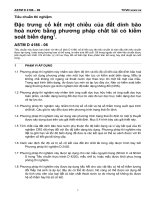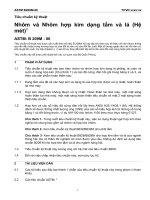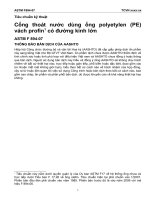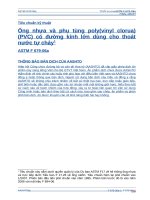Astm f 584 06
Bạn đang xem bản rút gọn của tài liệu. Xem và tải ngay bản đầy đủ của tài liệu tại đây (368.76 KB, 7 trang )
Designation: F 584 – 06
Standard Practice for
Visual Inspection of Semiconductor Lead-Bonding Wire1
This standard is issued under the fixed designation F 584; the number immediately following the designation indicates the year of
original adoption or, in the case of revision, the year of last revision. A number in parentheses indicates the year of last reapproval. A
superscript epsilon (e) indicates an editorial change since the last revision or reapproval.
1. Scope
1.1 This practice covers conditions for nondestructive visual
inspection of the surface finish of spooled aluminum and gold
wire used for making internal semiconductor device connections and hybrid microelectronic connections.
1.2 This practice specifies the recommended lighting, magnification, and specimen positioning for inspecting spooled
wire under an optical microscope.
1.3 Photographs (Figs. X1.1-X1.5 ) are included in Appendix X1 as guides to aid the inspector in identifying particular
surface conditions. These photographs are not intended as
standards for specifying wire surface quality.
1.4 The values stated in SI units are to be regarded as the
standard. The values given in parentheses are for information
only.
1.5 This standard does not purport to address all of the
safety concerns, if any, associated with its use. It is the
responsibility of the user of this standard to establish appropriate safety and health practices and determine the aplicability of regulatory limitations prior to use.
Fed. Std. No. 209B Clean Room and Work Station Requirements, Controlled Environment3
3. Terminology
3.1 Definitions of Terms Specific to This Standard:
3.1.1 chatter marks—for the purposes of this practice—
repetitive closely spaced wire surface blemishes.
3.1.2 dark area—for the purposes of this practice—wire
surface shadowed from direct light-source illumination.
3.1.3 fingerprint—for the purposes of this practice—
residual surface contamination deposited during handling.
4. Summary of Practice
4.1 The wire spool to be inspected is first mounted on a
holding fixture that permits rotation of the spool about its axis.
The spool fixture is then placed on the stage of a binocular
microscope. The wire surface is illuminated with light incident
at a grazing angle; the microscope and fixture are positioned so
that the microscope field shows the partially shadowed wire
wrap just adjacent to the brilliantly lit surface at the top of the
spool.
4.2 Inspection is accomplished by slowly rotating the spool
about its axis and moving the fixture over the microscope stage
until the operator has viewed the entire exposed wire surface
area under partially shadowed illumination.
4.3 The defects to be identified, the manner in which their
presence is reported, and the manner in which the wire surface
quality is to be characterized should be agreed upon by the
parties to the inspection.
2. Referenced Documents
2.1 ASTM Standards: 2
F 72 Specification for Gold Wire for Semiconductor Lead
Bonding
F 487 Specification for Fine Aluminum−1 % Silicon Wire
for Semiconductor Lead-Bonding
2.2 Federal Standard:
NOTE 1—Viewing a wire spool in the partial shadow of glancing
illumination is particularly revealing of surface flaws and soil. The
viewing arrangement amounts to dark-field illumination with imperfections appearing as bright glints on the wire surface.
1
This practice is under the jurisdiction of ASTM Committee F01 on Electronics
and is the direct responsibility of Subcommittee F01.07 on Interconnection
Bonding/Carrier Bonding.
Current edition approved Jan. 1, 2006. Published February 2006. Originally
approved in 1978. Last previous edition approved in 2005 as F 584 – 87(2005).
2
For referenced ASTM standards, visit the ASTM website, www.astm.org, or
contact ASTM Customer Service at For Annual Book of ASTM
Standards volume information, refer to the standard’s Document Summary page on
the ASTM website.
3
Available from Standardization Documents Order Desk, Bldg. 4 Section D, 700
Robbins Ave., Philadelphia, PA 19111-5094, Attn: NPODS.
Copyright © ASTM International, 100 Barr Harbor Drive, PO Box C700, West Conshohocken, PA 19428-2959, United States.
1
F 584 – 06
6. Apparatus
5. Significance and Use
5.1 Spooled wire viewed under bright direct lighting or in
deep shadow generally exhibits a flawless appearance. Proper
arrangement of the viewing angle and illumination, however,
permits accurate observation of wire-surface condition. This
practice specifies the conditions under which reliable and
reproducible surface finish inspection may be achieved. Such
inspection is appropriate for evaluating surface quality with
respect to the requirements in Specifications F 72 and F 487.
5.2 Surface smoothness and degree of cleanliness may
affect the performance of wire. This practice may be used to
determine whether or not spooled wire meets performancebased surface finish criteria agreed upon between a manufacturer or supplier and a wire purchaser.
5.3 The magnification recommended may not be sufficient
to permit detection of all defects on the wire surface affecting
wire performance; however, it is sufficient to permit an
inspector to determine the overall state of the wire finish and
the manner in which the wire lies on the spool.
6.1 Binocular Microscope—A microscope equipped with
zoom objective lens with basic magnification ranges up to 30
or 403.
6.2 Eyepieces, wide-field, with 103 magnification for a
binocular microscope.
6.3 Light Source—Use a fluorescent light similar to that in
Fig. 1.
6.4 Spool Inspection Jig, either of two types as follows:
6.4.1 Jig—A fixture of the mandrel type shown in Fig. 2,4
capable of positioning the spool so that the spool axis is
horizontal, and incorporating means for rotating the spool 360
deg about its axis during inspection, or
4
A detailed working drawing of the apparatus is available at a nominal cost from
ASTM, 100 Barr Harbor Drive, West Conshohocken, PA 19428. Order Adjunct
ADJF0584.
FIG. 1 General Arrangement of Apparatus
2
F 584 – 06
FIG. 2 One Form of Spool Inspection Jig
6.4.2 Machinist’s V-Block, of suitable size to support the
spool on its rims, with no contact between the V-block and the
wire.
practical substitute for the jig, although much greater operator care not to
damage the wire will be required.
6.5 Clean Room or Work Station—Laminar-flow facility
satisfying requirements for Class 1000 or higher, as defined in
Fed. Std. No. 209B.
NOTE 2—Use of the jig fixture is recommended. The jig provides more
convenient and sturdier support during inspection and minimizes the
possibility of spool contamination from handling. The jig dimensions
shown are intended for standard spools described in Specification F 72.
For occasional inspection, or for some particular spool designs, construction of a jig may not be warranted. The use of the V-block may then be a
7. Sampling
7.1 This practice is not intended for use as a 100 % screen;
therefore, sampling of spools is required.
3
F 584 – 06
8.6 Start the examination at either the left or right boundaries of the spool. Viewing the partially shadowed area of wire
wrap, slowly rotate the spool 360° about its axis. Note the
appearance of the wire surface and record the presence of
defects in the agreed-upon manner (see 4.3).
7.2 The sample should be representative of spools for the
intended use. The size of the sample and the method of
selection should be agreed upon by the parties to the inspection.
7.2.1 If sampling by lot is used, the definition of what
constitutes a lot should be agreed upon by the parties to the
inspection.
NOTE 4—Figs. X1.1-X1.5 in Appendix X1 illustrate typical surface
finish conditions.
8. Procedure
8.1 In the clean room or at the clean work station, mount the
spool to be examined onto the jig or V-block.
8.2 Position the jig or V-block so that the spool is in the field
of view of the microscope.
8.3 Position the light source so that (1) the light strikes the
spool at an angle of approximately 45° to the horizontal, (2) the
light source is in the vertical plane that includes the spool axis,
and (3) the distance between the light source and that part of
the upper surface of the spool in the microscope field is 18 cm
(7 in.) (see Fig. 1).
8.4 Set the microscope magnification to 303.
8.7 Continue the examination by moving the spool along its
axis in steps one viewing-field-width long and repeat 8.6 until
the entire spool surface has been viewed.
8.8 Remove the spool from the microscope stage at the
conclusion of the inspection.
9. Report
9.1 Report the following information:
9.1.1 Date of inspection,
9.1.2 Operator identification,
9.1.3 Spool lot identification,
9.1.4 Number of spools inspected,
9.1.5 Number of spools, total, in inspection lot,
9.1.6 Viewing magnification used if other than 303, and
9.1.7 Information on wire surface recorded in 8.6.
NOTE 3—Magnification of 303 provides sufficient resolution and
permits relatively fast and efficient inspection. In the course of the
inspection, higher or lower magnifications may be used, as necessary, to
provide a better view of areas of particular interest. In no case shall the
magnification be set so high that the depth of field is less than one half the
wire diameter.
10. Keywords
8.5 Adjust the spool position and microscope focus so that
the partially shadowed wire wrap just adjacent to the brilliantly
illuminated surface at the top of the spool is in clear view.
10.1 bonding wire; inspection; lead-bonding wire; semiconductor packaging; visual inspection; wire
APPENDIX
(Nonmandatory Information)
X1. PHOTOMICROGRAPHS OF TYPICAL WIRE DEFECTS AND OF DEFECT-FREE WIRE SURFACE
X1.1 See Figures Figs. X1.1-X1.5
4
F 584 – 06
FIG. X1.1 Wire with Defect-Free Surface
FIG. X1.2 Wire Contaminated by Fingerprint
5
F 584 – 06
FIG. X1.3 Wire with Mechanical Damage (Scratches and Nicks)
FIG. X1.4 Wire with Mechanical Damage (Stretch or Chatter Marks)
6
F 584 – 06
FIG. X1.5 Wire with Light Mechanical Damage (Minor Nicks)
ASTM International takes no position respecting the validity of any patent rights asserted in connection with any item mentioned
in this standard. Users of this standard are expressly advised that determination of the validity of any such patent rights, and the risk
of infringement of such rights, are entirely their own responsibility.
This standard is subject to revision at any time by the responsible technical committee and must be reviewed every five years and
if not revised, either reapproved or withdrawn. Your comments are invited either for revision of this standard or for additional standards
and should be addressed to ASTM International Headquarters. Your comments will receive careful consideration at a meeting of the
responsible technical committee, which you may attend. If you feel that your comments have not received a fair hearing you should
make your views known to the ASTM Committee on Standards, at the address shown below.
This standard is copyrighted by ASTM International, 100 Barr Harbor Drive, PO Box C700, West Conshohocken, PA 19428-2959,
United States. Individual reprints (single or multiple copies) of this standard may be obtained by contacting ASTM at the above
address or at 610-832-9585 (phone), 610-832-9555 (fax), or (e-mail); or through the ASTM website
(www.astm.org).
7









